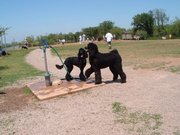Dog park
|
|
- This article is about the exercise area for dogs; there is also a Dog Park (movie).
A dog park is a facility set aside for dogs and their owners to exercise and play off-leash in a controlled environment. Parks vary in accoutrements, but a typical dog park is fenced; has separate, double-gated entry and exit points; a pond for swimming; hydrants for watering dogs; and tools to pick up and dispose of animal waste.
Benefits of off-leash dog parks
Pet ownership in the United States increased by over 1 million households between 1990 and 1992, up to 54 million, or 58% of all U.S. households. Of the pet-owning households, 38% included dogs. The number of dogs per dog-household was 1.5, totally 53.3 million dogs. (1) This trend is expected to continue into the new millennium.
While suburban and rural zones have traditionally been areas containing most of the pet-owning population, the urban environment has been undergoing an increase in pet population since the 1970s. This, combined with the fact that over the past 15 years urbanization has been taking over what was formerly considered to be suburban and rural areas, has resulted in a phenomenon called "urbananimalization." This, first of all, encompasses the recognition that animals are and will continue to be a "quality of life" aspect of urban society. Secondly, it recognizes that development must specifically provide for the inclusion of domestic animals in its growth plans.
As the dog companion population increases along with development, regulations need to be in place to promote responsible pet ownership, and facilities need to be provided to allow pet owners and their canine companions to exercise and play together. The provision of ample quality space for the human/dog companion recreation promotes the physical and mental well being of both dog and human.
Off-leash dog areas provide a social setting in which people can gather and interact in friendship. Off-leash dog areas are places where dog owners and nondog owners can delight in the entertaining and interesting interaction of dogs at play. Scientific studies have shown that people somehow find it easier to talk to each other with dogs as the initial focus, breaking down the usual social barriers that make people in our society perceive others as "strangers." Research has also shown that companion dogs improve people's health and increase resistance to disease by providing companionship, by giving people something to care for, by providing pleasurable activity, by providing a source of constancy in our changing lives, by stimulating people to exercise, by providing comfort with touch, and being a pleasure to watch. (2) The unconditional love of a companion animal is very beneficial.
The benefits to dogs is also well documented. Dogs that are highly socialized and exercised are healthier and happier. They make better neighbors because they bark and dig out of their enclosure less often. (If they do escape, they are far less likely to be aggressive. After all, they have met lots of people and other dogs before!) Off-leash dog areas are places of camaraderie and friendship. They are wonderful places used by caring and responsible people.
References
(1) "1992 National Pet Owners Study", Pet Business, August 1992
(2) "Pets and People: The Bonds Grow Stronger", Pet Business, February 1990
External links
- Dog park web site (http://www.dogpark.com/)
- General information about dog parks and starting a new dog park (http://www.dog-play.com/dogpark.html)
- Oklahoma City PAW Park (http://www.pawok.com/)
- Orange Dog Park Association (http://www.orangedogpark.com/)
- FETCH! (http://www.whidbey.com/fetch/) : Off-leash parks on Whidbey Island, Washington
- Dogparks of Greater St. Louis (http://www.stldogparks.org/)

